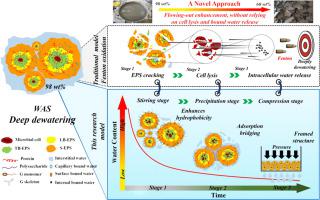当前位置:
X-MOL 学术
›
Water Res.
›
论文详情
Our official English website, www.x-mol.net, welcomes your feedback! (Note: you will need to create a separate account there.)
A novel approach for sludge deep-dewatering via flowing-out enhancement but not relying on cell lysis and bound water release
Water Research ( IF 12.8 ) Pub Date : 2024-05-06 , DOI: 10.1016/j.watres.2024.121743 Hao Zhang , Wen-Hui Liu , Yun-Yan Gao , Ping Sun , Yuan-Ping Zeng , Lin-Lin Ma , Jiang-Nan Wu , Shun-Gui Zhou , Xi-Qin Cui , Raymond Jianxiong Zeng , Hou-Feng Wang
Water Research ( IF 12.8 ) Pub Date : 2024-05-06 , DOI: 10.1016/j.watres.2024.121743 Hao Zhang , Wen-Hui Liu , Yun-Yan Gao , Ping Sun , Yuan-Ping Zeng , Lin-Lin Ma , Jiang-Nan Wu , Shun-Gui Zhou , Xi-Qin Cui , Raymond Jianxiong Zeng , Hou-Feng Wang

|
Effective deep-dewatering is crucial for wastewater sludge management. Currently, the dominant methods focus on promoting cell lysis to release intracellular water, but these techniques often lead to secondary pollution and require stringent conditions, limiting their practical use. This study explores an innovative method using a commercially available complex quaternary ammonium salt surfactant, known as G-agent. This agent remarkably reduces the sludge water content from 98.6 % to 56.8 % with a low dosage (50 mg/g DS) and under neutral pH conditions. This approach surpasses Fenton oxidation in terms of dewatering efficiency and avoids the necessity for cell lysis and bound water release, thereby reducing the risk of secondary pollution in the filtrate, including heavy metals, nitrogen, phosphorus, and other contaminants. The G-agent plays a significant role in destabilizing flocs and enhancing flocculation during the conditioning and initial dewatering stages, effectively reducing the solid-liquid interfacial affinity of the sludge. In the compression filtration stage, the agent's solidification effect is crucial in forming a robust skeleton that improves pore connectivity within the filter cake, leading to increased water permeability, drainage performance and water flow-out efficiency. This facilitates deep dewatering of sludge without cell lysis. The study reveals that the G-agent primarily improves water flow-out efficiency rather than water flowability, indicating that cell lysis and bound water release are not indispensable prerequisites for sludge deep-dewatering. Furthermore, it presents an encouraging prospect for overcoming the limitations associated with conventional sludge deep-dewatering processes.
中文翻译:

一种通过增强流出而不依赖于细胞裂解和结合水释放进行污泥深度脱水的新方法
有效的深度脱水对于废水污泥管理至关重要。目前,主流方法集中于促进细胞裂解释放细胞内水,但这些技术往往会导致二次污染,且需要严格的条件,限制了其实际应用。本研究探索了一种使用市售复合季铵盐表面活性剂(称为 G-agent)的创新方法。该药剂在低剂量(50 mg/g DS)和中性 pH 条件下可将污泥含水量从 98.6% 显着降低至 56.8%。该方法在脱水效率方面超越了芬顿氧化,并且避免了细胞裂解和结合水释放的必要性,从而降低了滤液二次污染的风险,包括重金属、氮、磷等污染物。 G剂在调理和脱水初期起到去稳定絮体和增强絮凝作用,有效降低污泥的固液界面亲和力。在压缩过滤阶段,药剂的固化作用对于形成坚固的骨架至关重要,从而改善滤饼内的孔隙连通性,从而提高透水性、排水性能和水流出效率。这有利于污泥深度脱水而无需细胞裂解。研究表明,G剂主要提高水的流出效率而不是水的流动性,这表明细胞裂解和结合水释放并不是污泥深度脱水不可或缺的先决条件。此外,它为克服传统污泥深度脱水工艺的局限性提供了令人鼓舞的前景。
更新日期:2024-05-06
中文翻译:

一种通过增强流出而不依赖于细胞裂解和结合水释放进行污泥深度脱水的新方法
有效的深度脱水对于废水污泥管理至关重要。目前,主流方法集中于促进细胞裂解释放细胞内水,但这些技术往往会导致二次污染,且需要严格的条件,限制了其实际应用。本研究探索了一种使用市售复合季铵盐表面活性剂(称为 G-agent)的创新方法。该药剂在低剂量(50 mg/g DS)和中性 pH 条件下可将污泥含水量从 98.6% 显着降低至 56.8%。该方法在脱水效率方面超越了芬顿氧化,并且避免了细胞裂解和结合水释放的必要性,从而降低了滤液二次污染的风险,包括重金属、氮、磷等污染物。 G剂在调理和脱水初期起到去稳定絮体和增强絮凝作用,有效降低污泥的固液界面亲和力。在压缩过滤阶段,药剂的固化作用对于形成坚固的骨架至关重要,从而改善滤饼内的孔隙连通性,从而提高透水性、排水性能和水流出效率。这有利于污泥深度脱水而无需细胞裂解。研究表明,G剂主要提高水的流出效率而不是水的流动性,这表明细胞裂解和结合水释放并不是污泥深度脱水不可或缺的先决条件。此外,它为克服传统污泥深度脱水工艺的局限性提供了令人鼓舞的前景。






























 京公网安备 11010802027423号
京公网安备 11010802027423号